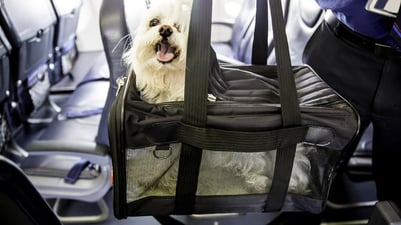You are moving or going on vacation to Spain. Super nice! However, there is one thing holding you back, and that is having to leave your beloved pet behind. So why not just take your dog or cat on the plane? Some airlines allow it! Of course, there are some rules and conditions attached. IMMOFY investigated it for you.
WHEN CAN MY PET COME ON BOARD?
A first requirement that applies to every airline is that your pet is in good health. Flying brings a lot of extra stress for animals, so both for the sake of your pet and your fellow passengers, it is important that your dog or cat does not show any signs of illness beforehand.
In general, it is required that:
- your pet is at least three months old and transported in an IATA-approved transport bag/box. The dimensions and maximum allowed weight differ per airline. The pet must remain in the transport container during the flight.
- your pet meets the health and import requirements of the destination country, such as valid vaccination certificates, an EU passport, a health certificate from the vet, and a microchip.
- Bringing a pet must be notified in advance to the respective airline.
- Assistance animals: Service or guide dogs are always allowed in the cabin. Advance notification is necessary, and documentation must show that it is indeed a service dog.
- There are always limited places available for pets in the cabin, so it is important to arrange this as early as possible.
- Extra costs apply and vary depending on the destination and type of flight. For the cabin, prices range between 45 - 80€, and for the hold between 70-200€.
- Dogs and cats with a flat nose: Separate rules apply, as they often have breathing difficulties. Check these with the airline.
HOW IS MY PET TRANSPORTED ON THE PLANE?
There are three ways your pet can be transported, depending on the size of the animal and the airline.
- In the cabin: Only for cats and smaller dogs that fit in a travel bag with predetermined dimensions. This travel bag counts as your hand luggage. There is also a maximum weight for the animal. In this case, your pet travels with you on the plane.
- In the hold: For small, medium, and large dogs. Your dog travels in a travel kennel or transport box in the same plane as you but in a separate, temperature-controlled environment.
- As cargo: Mainly for large dogs. This is the cheapest option, but it also means that your dog may not travel in the same plane as you. For dogs over 75 kg, this is the only option with most airlines.
AN OVERVIEW PER AIRLINE
Although many general rules overlap, each airline still has specific conditions that must be met before your four-legged friend can board the plane. IMMOFY provides you with an overview of the most popular airlines (for Spain) and their regulations regarding pet transport.
1. TUI fly
See general rules above.
- Pet in the cabin: The dog or cat must fit in a kennel that meets the maximum dimensions of the airline. Together, the kennel and the animal must not weigh more than 8 kg. The pet must remain in the kennel during the flight. Prior permission is needed, and there are limited places.
- Pet in the hold: If your pet cannot travel in the cabin, it will be placed in a heated hold in an approved kennel. A bench is not allowed. The kennel must be large enough for your pet to turn around, stand, and lie down comfortably. The kennel dimensions must meet IATA guidelines. This mode of transport is at your own risk, and at check-in, you must sign a Form of Indemnity;
- Dogs and cats with a flat nose: Separate rules apply due to breathing difficulties. These pets must be registered via the cargo handler ECS. TUI does not transport English and French bulldogs, pugs, and Boston Terriers in the hold.
Specific information about taking pets on a European flight with TUI fly can be found on their official website. Here is the direct link to the relevant page:
On this page, you will find all the details about the rules, conditions, and costs for taking pets on European flights with TUI fly. Make sure to read this information carefully and contact TUI fly customer service for any questions or additional information.
2. Brussels Airlines
See general rules above.
- Pet in the cabin: The dog or cat must be transported in a travel bag, and together they must not exceed the weight of 8 kg. The bag must meet the maximum dimensions and fit under the seat in front of you. The animal can also travel if it is pregnant. If you have 2 small dogs that can fit in 1 travel bag, you only need to pay for 1 dog as long as you do not exceed 8 kg. Note, you must register both during booking. A maximum of 4 pets are allowed per flight;
- Pet in the hold: All cats or dogs can travel in the hold. The bag or cage must have rigid walls, ventilation openings, and be large enough for the animal to stand, turn, and lie down. The animal must NOT be pregnant;
- Animals as cargo: Besides cats and dogs, all other animals and wild animals must travel in the cargo hold;
- Dogs and cats with a flat nose: They can travel in the cabin, in the hold, or as cargo, provided you have the necessary approval. To transport assistance animals in the cabin or hold, fill out this form. To transport your animal as cargo, fill out the release form. Both must be sent in advance to release@brusselsairlines.com;
Information about taking pets on European flights with Brussels Airlines can be found on their official website. Here is the direct link to the relevant page:
Brussels Airlines - Traveling with pets
On this page, you will find all the details about the rules, conditions, and costs for taking pets on European flights with Brussels Airlines. Make sure to read this information carefully and contact Brussels Airlines customer service for any questions or additional information.
Book in advance the transport of your animal via the Brussels Airlines Service Centre.
3. Vueling
See general rules above.
- Pet in the cabin: Your pet (dog, cat, fish, turtle) must be transported in a flexible kennel that does not exceed the maximum dimensions of the airline, and together the animal and kennel must not weigh more than 10 kg. During the flight, the travel kennel must be placed on the floor, between your legs or under the seat in front of you. A maximum of 3 pets are allowed per flight;
- Vueling does not transport animals in the hold of the plane;
- Assistance animals: Assistance and guide dogs must be at least three months old and identified via a tattoo or microchip. You must also have an official document proving that your dog is trained as a service or guide dog. The dog can travel in the cabin but must fit between your legs or under the seat in front of you and be secured with a safety harness;
Information about taking pets on European flights with Vueling can be found on their official website. Here is the direct link to the relevant page:
On this page, you will find all the details about the rules, conditions, and costs for taking pets on European flights with Vueling. Make sure to read this information carefully and contact Vueling customer service for any questions or additional information.
4. Ryanair
- Ryanair prohibits the transport of pets on their flights, with the exception of guide dogs and assistance dogs;
- Assistance animals: The guide dog or assistance dog must have a valid EU passport or official veterinary certificate including the required medical documentation and be certified by an organization that is a member of Assistance Dogs International (ADI), Assistance Dogs UK, or International Guide Dog Federation (IGDF). During the flight, the dog must sit on the floor at the feet of the passenger;
Notify Ryanair in advance, preferably at the time of booking, that you are bringing an assistance or guide dog on board. This can be done via the special assistance line.
5. Easyjet
- Pets are not allowed on Easyjet flights, with the exception of recognized, registered assistance dogs;
- Assistance dogs: Assistance dogs must have an official document from Assistance Dogs International (ADI), Koninklijk Nederlands Geleidehonden Fonds (KNGF), or International Guide Dog Federation (IGDF);
Rates: Traveling with a registered guide or assistance dog is free;
Special assistance for assistance dogs can be added at the time of booking or afterwards by logging in via 'Manage bookings on easyjet.com. You can also contact via email: special.assistance@easyjet.com with the subject 'Request for special assistance', ideally 14 days before departure and at least 48 hours in advance.
6. Iberia
See general rules above.
- Pet in the cabin: Your pet (dog, cat, fish, turtle, or bird) must be transported in a strong, ventilated cage with a water-absorbent bottom. The maximum dimensions are listed on the website. Together, the animal and the cage must not weigh more than 8 kg. A maximum of 2 pets are allowed per flight;
- Pet in the hold: Dogs and cats can be transported in the hold in a sturdy cage that is large enough for the animal to stand up straight. The cage must be ventilated and have a water-resistant bottom. The maximum weight of the animal and the cage is 45 kg;
- Assistance dogs: Traveling with a guide or assistance dog must be requested at least 48 hours before the flight departure via Serviberia (Spanish & English): (+31) 900 777 7717 or (+32)2 585 51 98;
- Dogs and cats with a flat nose: For safety reasons, dogs and cats with a flat nose can only be transported in the cabin. Dangerous dog breeds are not allowed on an Iberia flight.
Information about taking pets on European flights with Iberia can be found on their official website. Here is the direct link to the relevant page:
On this page, you will find all the details about the rules, conditions, and costs for taking pets on European flights with Iberia. Make sure to read this information carefully and contact Iberia customer service for any questions or additional information.

7. KLM
See general rules above.
- Your pet must be at least 10 weeks old;
- Your pet (dog or cat) must have an EU passport stating that it has been vaccinated against rabies;
- Pet in the cabin: Small dogs or cats are allowed to travel in the cabin on KLM flights, in a kennel or travel bag with maximum dimensions listed on the website. Together they must not exceed the maximum weight of 8 kg. The kennel must be made of fiberglass or hard plastic and equipped with absorbent material;
- Pet in the hold: Your pet must travel in a kennel that meets IATA rules, and the total weight of the pet and kennel must not exceed 75 kg. Each pet must travel in its own kennel. However, 2 cats or 2 dogs of similar size up to 14 kg each that are compatible, or 3 animals up to six months old from the same litter up to 14 kg each, may travel in the same kennel. A maximum of 3 pets are allowed in the hold;
- Assistance dogs: Special conditions apply for traveling with assistance dogs. More information can be requested via KLM CARES
- Dogs and cats with a flat nose: These animals can only be transported in the cabin or as cargo. English and French bulldogs, Boston terriers, and pugs can only be transported in the cabin;
Information about taking pets on European flights with KLM can be found on their official website. Here is the direct link to the relevant page:
On this page, you will find all the details about the rules, conditions, and costs for taking pets on European flights with KLM. Make sure to read this information carefully and contact KLM customer service for any questions or additional information.
8. Lufthansa
See general rules above.
A maximum of 2 pets are allowed per flight (both cabin and hold);
Pet in the cabin: Only small dogs and cats with a maximum weight of 8 kg, including travel bag, may be transported in the cabin of the plane. The travel bag must be made of soft material and must be equipped with absorbent material. To take your pet as hand luggage, certain conditions must be met as formulated in this form. This must be filled in twice and handed over at the check-in counter;
Pet in the hold: Dogs and cats that, including kennel, weigh more than 8 kg, go in the ventilated hold of the plane. The kennel must comply with IATA (International Air Transport Association) regulations and be large enough so that the animal can move freely. The kennel must have ventilation holes on all four sides and it must also be equipped with absorbent material;
Assistance dogs: Assistance dogs may travel free of charge in the cabin of the plane, provided that you can present two copies of the SVAN or ESAN form fully completed and signed at the check-in counter;
Dogs and cats with a flat snout: For safety reasons for the animal, Lufthansa only transports these animals via Lufthansa Cargo;
Your pet must be registered with Lufthansa at least 24 hours before the departure of the flight (and you must have received confirmation). For assistance dogs, the deadline is 48 hours before departure. It is recommended to register your animal as soon as possible, preferably at the time of booking, through your travel agency or the Lufthansa Service Center or by sending an email to the Lufthansa Medical Operation Centre.
Information about taking pets on European flights with KLM can be found on their official website. Here is the direct link to the relevant page:
Lufthansa - Travelling with pets
On this page, you will find all the details about the rules, conditions, and costs for taking pets on European flights with KLM. Make sure to read this information carefully and contact KLM customer service if needed for any questions or additional information.
9. Transavia
Your pet must be at least three months and 21 days old;
Pet in the cabin: You can take your pet in the cabin in an IATA travel bag or kennel with maximum dimensions according to Transavia guidelines, and together they must not exceed the maximum weight of 10 kg.
Pet in the hold: You can also transport your dog or cat in the specially heated hold in a kennel that meets the legal requirements of IATA (International Air Transport Association). The kennel must be made of fiberglass or hard plastic and be large enough so that the animal can move comfortably. The maximum weight of the animal including kennel is 75 kg. A maximum of 2 pets are allowed per flight in the hold;
Assistance dogs: Your assistance dog is allowed in the cabin and must sit at your feet on a leash during the flight. The animal must be certified by an organization that is a member of Assistance Dogs International (ADI), International Guide Dog Federation (IGDF), or another organization;
Dogs and cats with a flat snout: For their own well-being, these animals may only be transported in the cabin. Fighting or attack dogs are not allowed on board;
Information about taking pets on European flights with KLM can be found on their official website. Here is the direct link to the relevant page:
Transavia - Travelling with pets
On this page, you will find all the details about the rules, conditions, and costs for taking pets on European flights with KLM. Make sure to read this information carefully and contact KLM customer service if needed for any questions or additional information.
You must book your pet in advance (at the time of booking or later via My Transavia). This can be done up to two hours before the departure of the plane.
Now that you know all this, you have no excuse to leave your best friend at home. This way, you can enjoy a wonderful stay in Spain together!



